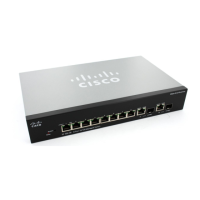Configuring Quality of Service
QoS Features and Components
Cisco Small Business 300 Series Managed Switch Administration Guide 247
18
QoS includes the following:
• Traffic Classification—Classifies each incoming packet as belonging to a
specific traffic flow, based on the packet contents and/or the port.The
classification is done by ACL (Access Control List), and only traffic that
meets the ACL criteria is subject to CoS or QoS classification
• Assignment to Hardware Queues—Assigns incoming packets to
forwarding queues. Packets are sent to a particular queue for handling as a
function of the traffic class to which they belong.
• Other Traffic Class-Handling Attribute—Applies QoS mechanisms to
various classes, including bandwidth management.
QoS Modes
The QoS mode that is selected applies to all interfaces in the system.
• Basic Mode—Class of Service (CoS).
All traffic of the same class receives the same treatment, which is the single
QoS action of determining the egress queue on the egress port, based on
the indicated QoS value in the incoming frame. This is the VLAN Priority Tag
(VPT) 802.1p value in Layer 2 and the Differentiated Service Code Point
(DSCP) value for IPv4 or Traffic Class (TC) value for IPv6 in Layer 3. When
operating in Basic Mode, the switch trusts this external assigned QoS value.
The external assigned QoS value of a packet determines its traffic class
and QoS.
The header field to be trusted is entered in the
Global Settings Page
. For
every value of that field, an egress queue is assigned where the frame is
sent in the
CoS/802.1p to Queue Page
or the
DSCP to Queue Page
(depending on whether the trust mode is CoS/802.1p or DSCP,
respectively).
• Advanced Mode—Per-flow Quality of Service (QoS).
In advanced mode, a per flow QoS consists of a class map and a policer:
- A class map defines the kind of traffic in a flow, and contains one or more
ACLs. Packets that match the ACLs belong to the flow.
- A policer applies the configured QoS to a flow. The QoS configuration of
a flow may consist of egress queue, the DSCP or CoS/802.1p value, and
actions on out of profile (excess) traffic.

